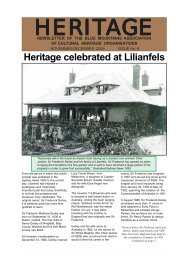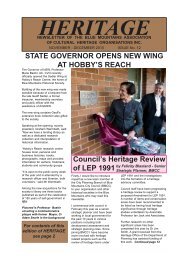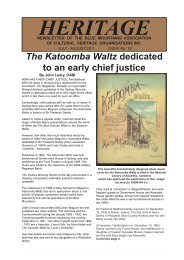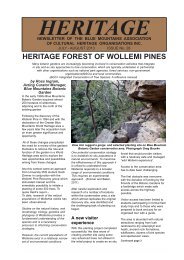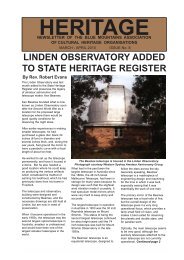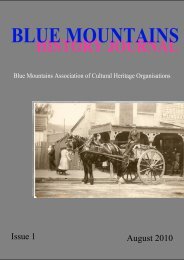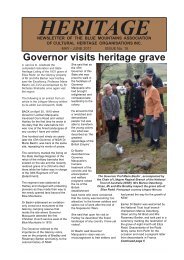Blue Mountains History Journal Issue 2
Blue Mountains History Journal Issue 2
Blue Mountains History Journal Issue 2
You also want an ePaper? Increase the reach of your titles
YUMPU automatically turns print PDFs into web optimized ePapers that Google loves.
<strong>Blue</strong> <strong>Mountains</strong> <strong>History</strong> <strong>Journal</strong> 2; 2011<br />
Figure 9. Pilgrim Inn, Lapstone Hill<br />
(Martindale 1860b; Mitchell Library, SLNSW).<br />
Figure 10. <strong>Blue</strong> Mountain Inn<br />
(Martindale 1860b; Mitchell Library<br />
SLNSW)<br />
foreground at the very edge of the precipice, Govetts Leap waterfall to one side and the vastness of the<br />
valley receding in a misty haze. Two tiny figures, they look out upon the grandeur of the scene,<br />
embracing the ‘sublime’ power and beauty of Nature. The Captain may well have had other less poetic<br />
thoughts in mind, however, considering his recent experience attempting to implement the<br />
Government’s decision to survey a rail route through the Grose Valley, an undertaking that one historian<br />
has dismissed as a typically “unsupervised project which gets out of hand” (Macqueen 1997, p.62).<br />
Figure 11. Govetts Leap and the Grose Valley (Martindale 1860b; Mitchell Library, SLNSW).<br />
It is surprising that Martindale, when new to the colony and unfamiliar with the <strong>Blue</strong> <strong>Mountains</strong><br />
landscape, allowed the situation in the Grose to develop as it did and did not personally inspect the site<br />
in the early stages of the project. Had he done so, the environmental impracticalities would surely have<br />
been apparent to an engineer of his experience and ability. As scenically stunning as a line through<br />
the valley must have seemed, the sharp bends, deep gullies, cliffs, flood and landslide prone areas and<br />
the impossible gradient encountered where the line was intended to enter the proposed tunnel through<br />
the Darling Causeway would all have warned him of the unsuitability of the terrain. Nevertheless, for<br />
whatever reason, he and his Engineer-in-Chief John Whitton did not visit the valley until work was<br />
well underway, relying instead upon the overly optimistic reports of the engineer in charge of the survey<br />
team. As delay followed delay and the cost mounted, public pressure grew. Within a few months of<br />
Martindale’s final site inspection in January 1860 the truth was admitted and the survey team withdrawn<br />
from the valley. Ironically, Martindale Hill in the lower Grose Valley, originally named in 1961 by<br />
Myles Dunphy as ‘Mt. Martindale’ but changed by the Geographical Names Board in 1969 (Fox 2006,<br />
item 1297), remains the only public reminder of Ben Hay Martindale’s time in Australia.<br />
7 Back to Contents




